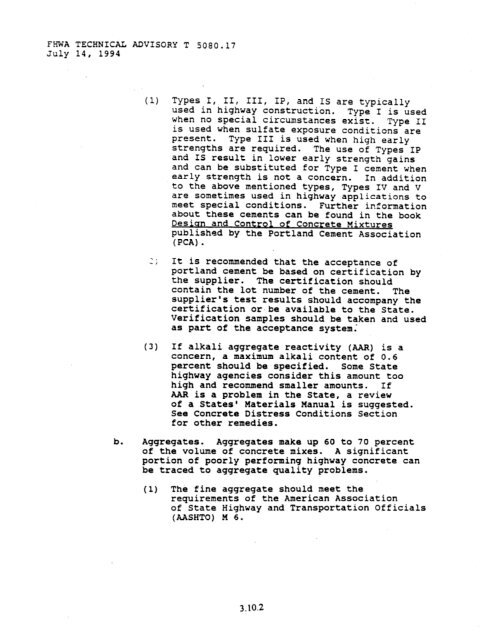chapter 3 rigid pavement - DOT On-Line Publications - Department ...
chapter 3 rigid pavement - DOT On-Line Publications - Department ...
chapter 3 rigid pavement - DOT On-Line Publications - Department ...
Create successful ePaper yourself
Turn your PDF publications into a flip-book with our unique Google optimized e-Paper software.
FHWA TECHNICAL ADVISORY T 5080.17<br />
July 14, 1994<br />
(1)<br />
. ><br />
‘I<br />
(3)<br />
Types 1, II, III, IP, and IS are typically<br />
used in highway construction. Type I is used<br />
when no special circumstances exist. Type II<br />
is used when sulfate exposure conditions are<br />
present. Type III is used when high early<br />
strengths are required. The use of Types IP<br />
and IS result in lower early strength gains<br />
and can be substituted for Type I cement when<br />
early strength is not a concern. In addition<br />
to the above mentioned types, Types IV and V<br />
are sometimes used in highway applications to<br />
meet special conditions. Further information<br />
about these cements can be found in the book<br />
Desian and Control of Concrete Mixtures<br />
published by the Portland Cement Association<br />
(PCA).<br />
It is recommended that the acceptance of<br />
portland cement be based on certification by<br />
the supplier. The certification should<br />
contain the lot number of the cement. The<br />
supplier's test results should accompany the<br />
certification or.be available to the State.<br />
Verification samples should be taken and used<br />
as part of the acceptance system,<br />
If alkali aggregate reactivity (AAR) is a<br />
concern, a maximum alkali content of 0.6<br />
percent should be specified. Some State<br />
highway agencies consider this amount too<br />
high and recommend smaller amounts. If<br />
AAR is a problem in the State, a review<br />
of a States' Materials Manual is suggested.<br />
See Concrete Distress Conditions Section<br />
for other remedies.<br />
b. Aggregates. Aggregates make up 60 to 70 percent<br />
of the volume of concrete mixes. A significant<br />
portion of poorly performing highway concrete can<br />
be traced to aggregate quality problems.<br />
(1) The fine aggregate should meet the<br />
requirements of the American Association<br />
of State Highway and Transportation Officials<br />
(AASHTO) M 6.<br />
3.10.2
















